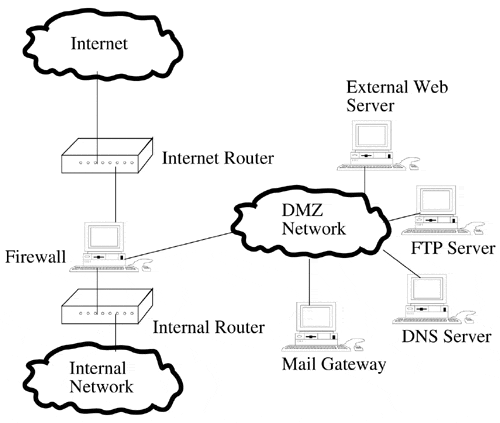Roles and Responsibilities
Roles and Responsibilities
The following sections detail the various roles and responsibilities of IT personnel and support services typically included in the WCPA guide.
Internet Engineering
Internet Engineering is the group responsible for operating the company's Internet access. In a large company, it is typical to have multiple, geographically separate routes from internal networks to the Internet, both for load sharing and reliability. Internet Engineering is responsible for the principal external servers in the "demilitarized zone" or DMZ. The DMZ is that portion of the network that sits behind the first firewall but outside of the main internal networks, as shown in Figure 13-1.
Figure 13-1. Sample Internet Firewall and DMZ Network

Typical responsibilities of Internet Engineering include:
-
Determining requirements for Internet connectivity
-
Contracting for ISP (Internet Service Provider) services
-
Installing and maintaining external web, ftp, and e-mail servers
-
Installing and maintaining external DNS and other directory servers
-
Monitoring ISP performance and service level agreements
Security Engineering
Security is a specialized enough topic that it is called out separately in the WCPA. Typical responsibilities of Security Engineering include:
-
Designing and maintaining firewall complex, possibly in conjunction with Internet Engineering
-
Working with Internet Engineering to assure security of all external servers
-
Working with Network Engineering to assure security of all internal networks
-
Working with WebTone engineering to provide secure access through the firewall
-
Designing and implementing methods for remote user authentication and data encryption
Network Engineering
Typical responsibilities of Network Engineering include:
-
Determining internal networking requirements, both for WANs and LANs
-
Contracting with Telcos for WAN services
-
Installing and maintaining all WAN and LAN routers, switches, and hubs
-
Determining impact of new applications on the network
WebTone Engineering
Typical responsibilities of WebTone Engineering include:
-
Working with Internet engineering to hand off incoming and outgoing web, ftp, and e-mail traffic
-
Installing and maintaining internal DNS and other directory services
-
Providing internal web server hosting
-
Designing and maintaining a network of internal proxy cache servers at strategic points on the corporate Intranet
Technical Support
Typical responsibilities of Technical Support include:
-
Determining physical location of all server equipment
-
Installing network connections and power
-
Installing hardware, including third party equipment
-
Conducting preventive maintenance diagnostics on all equipment
-
Partitioning the disks during OS installation
-
Configuring operating system specific parameters
-
Applying any operating system patches required
-
Assisting database administration with DBMS installations
-
Installing any unbundled software products, such as tape management, disk mirroring, etc.
-
Installing all required data center utilities
-
Configuring and maintaining system security
-
Monitoring system performance and capacity (CPU, memory, disk, network)
-
Managing backup tape integrity and storage
-
Providing on-call support, 7x24, or as specified
-
Performing disaster recovery drills
-
Establishing end-of-life plans to deactivate servers and applications
-
Providing online availability statistics
-
Providing system tuning for peak performance
-
Performing capacity planning
-
Establishing network connections to LAN and WAN, including ISP (Internet Service Provider) connections
-
Providing and maintaining network databases such as DNS, LDAP, NIS, NFS, Primary Domain Controller (NT), Backup Domain Controller (NT)
-
Performing security audits ; monitoring security access
-
Establishing user accounts and system (root) accounts
-
Monitoring all daily processing
-
Starting/restarting production jobs and applications
-
Scheduling all online and batch processing
-
Evaluating, developing, and implementing utilities and tools to support servers and applications in the production environment
Hardware Support
Typical responsibilities of Hardware Support include:
-
Supporting and resolving all hardware problems
-
Handling all preventive maintenance within the data center for mission-critical servers
Applications Support
Typical responsibilities of Applications Support include:
-
Providing second-level application support as required
-
Working with technical support and database administration to resolve complex application problems
EAN: 2147483647
Pages: 193